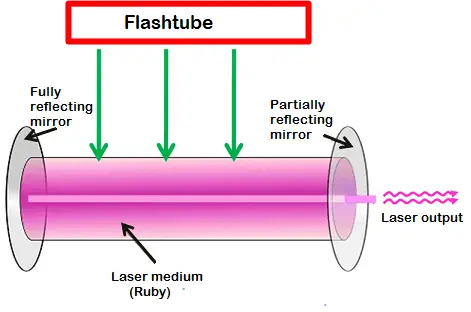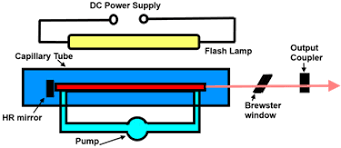What is a laser?
LASER stands for Light Amplification by Stimulated Emission of Radiation. A laser is a device which produces highly directional light. It emits light through a process called stimulated emission of radiation which increases the intensity of light.
A laser is different from conventional light sources in four ways: coherence, directionality, monochromacity, and high intensity.
The light waves of ordinary light sources have many wavelengths. Hence, the photons emitted by ordinary light sources are out of phase. Thus, ordinary light is incoherent.
On the other hand, the light waves of laser light have only one wavelength. Hence, all the photons emitted by laser light are in phase. Thus, laser light is coherent.
The light waves from laser contain only one wavelength or color so it is known as monochromatic light.
The laser beam is very narrow and can be concentrated on a very small area. This makes laser light highly directional.
The laser light spreads in a small region of space. Hence, all the energy is concentrated on a narrow region.Therefore, laser light has greater intensity than the ordinary light.
Types of lasers
Lasers are classified into 4 types based on the type of laser medium used:
- Solid-state laser
- Gas laser
- Liquid laser
- Semiconductor laser
A solid-state laser is a laser that uses solid as a laser medium. In these lasers, glass or crystalline materials are used.
Ions are introduced as impurities into host material which can be a glass or crystalline. The process of adding impurities to the substance is called doping. Rare earth elements such as cerium (Ce), erbium (Eu), terbium (Tb) etc are most commonly used as dopants.
Materials such as sapphire (Al2O3), neodymium-doped yttrium aluminum garnet (Nd:YAG), Neodymium-doped glass (Nd:glass) and ytterbium-doped glass are used as host materials for laser medium. Out of these, neodymium-doped yttrium aluminum garnet (Nd:YAG) is most commonly used.
The first solid-state laser was a ruby laser. It is still used in some applications. In this laser, a ruby crystal is used as a laser medium.

In solid-state lasers, light energy is used as pumping source. Light sources such as flashtube, flash lamps, arc lamps, or laser diodes are used to achieve pumping.
Semiconductor lasers do not belong to this category because these lasers are usually electrically pumped and involve different physical processes.
Gas laser
A gas laser is a laser in which an electric current is discharged through a gas inside the laser medium to produce laser light. In gas lasers, the laser medium is in the gaseous state.

Gas lasers are used in applications that require laser light with very high beam quality and long coherence lengths.
In gas laser, the laser medium or gain medium is made up of the mixture of gases. This mixture is packed up into a glass tube. The glass tube filled with the mixture of gases acts as an active medium or laser medium.
A gas laser is the first laser that works on the principle of converting electrical energy into light energy. It produces a laser light beam in the infrared region of the spectrum at 1.15 µm.
Gas lasers are of different types: they are, Helium (He) – Neon (Ne) lasers, argon ion lasers, carbon dioxide lasers (CO2 lasers), carbon monoxide lasers (CO lasers), excimer lasers, nitrogen lasers, hydrogen lasers, etc. The type of gas used to construct the laser medium can determine the lasers wavelength or efficiency.
Liquid laser
A liquid laser is a laser that uses the liquid as laser medium. In liquid lasers, light supplies energy to the laser medium.
A dye laser is an example of the liquid laser. A dye laser is a laser that uses an organic dye (liquid solution) as the laser medium.
A dye laser is made up of an organic dye mixed with a solvent. These lasers generate laser light from the excited energy states of organic dyes dissolved in liquid solvents. It produces laser light beam in the near ultraviolet (UV) to the near infrared (IR) region of the spectrum.

Semiconductor laser
Semiconductor lasers play an important role in our everyday life. These lasers are very cheap, compact size and consume low power. Semiconductor lasers are also known as laser diodes.
Semiconductor lasers are different from solid-state lasers. In solid-state lasers, light energy is used as the pump source whereas, in semiconductor lasers, electrical energy is used as the pump source.
In semiconductor lasers, a p-n junction of a semiconductor diode forms the active medium or laser medium. The optical gain is produced within the semiconductor material.



